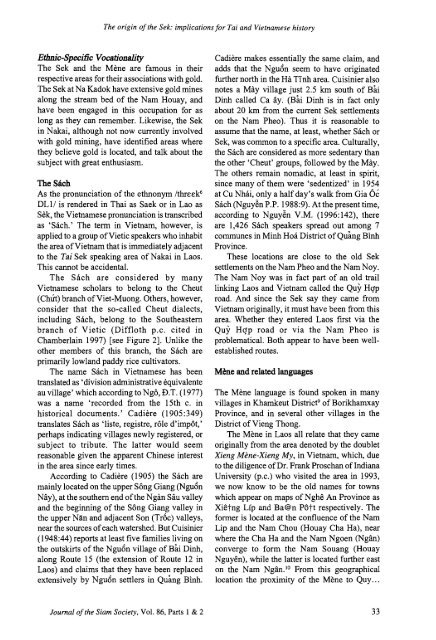The Journal of the Siam Society Vol. LXXXVI, Part 1-2 ... - Khamkoo
The Journal of the Siam Society Vol. LXXXVI, Part 1-2 ... - Khamkoo
The Journal of the Siam Society Vol. LXXXVI, Part 1-2 ... - Khamkoo
Create successful ePaper yourself
Turn your PDF publications into a flip-book with our unique Google optimized e-Paper software.
<strong>The</strong> origin <strong>of</strong> <strong>the</strong> Sek: implications for Tai and Vietnamese history<br />
Ethnic-Specific Vocationality<br />
<strong>The</strong> Sek and <strong>the</strong> Mene are famous in <strong>the</strong>ir<br />
respective areas for <strong>the</strong>ir associations with gold.<br />
<strong>The</strong> Sek at Na Kadok have extensive gold mines<br />
along <strong>the</strong> stream bed <strong>of</strong> <strong>the</strong> Nam Houay, and<br />
have been engaged in this occupation for as<br />
long as <strong>the</strong>y can remember. Likewise, <strong>the</strong> Sek<br />
in Nakai, although not now currently involved<br />
with gold mining, have identified areas where<br />
<strong>the</strong>y believe gold is located, and talk about <strong>the</strong><br />
subject with great enthusiasm.<br />
<strong>The</strong> Slich<br />
As <strong>the</strong> pronunciation <strong>of</strong> <strong>the</strong> ethnonym /thre:e:k 6<br />
DLll is rendered in Thai as Saek or in Lao as<br />
Sek, <strong>the</strong> Vietnamese pronunciation is transcribed<br />
as 'Sach.' <strong>The</strong> term in Vietnam, however, is<br />
applied to a group <strong>of</strong>Vietic speakers who inhabit<br />
<strong>the</strong> area <strong>of</strong> Vietnam that is immediately adjacent<br />
to <strong>the</strong> Tai Sek speaking area <strong>of</strong> Nakai in Laos.<br />
This cannot be accidental.<br />
<strong>The</strong> Sach are considered by many<br />
Vietnamese scholars to belong to <strong>the</strong> Cheut<br />
(Chili) branch <strong>of</strong>Viet-Muong. O<strong>the</strong>rs, however,<br />
consider that <strong>the</strong> so-called Cheut dialects,<br />
including Sach, belong to <strong>the</strong> Sou<strong>the</strong>astern<br />
branch <strong>of</strong> Vietic (Diffloth p.c. cited in<br />
Chamberlain 1997) [see Figure 2]. Unlike <strong>the</strong><br />
o<strong>the</strong>r members <strong>of</strong> this branch, <strong>the</strong> Sach are<br />
primarily lowland paddy rice cultivators.<br />
<strong>The</strong> name Sach in Vietnamese has been<br />
translated as 'division administrative equivalente<br />
au village' which according to N go, f). T. ( 1977)<br />
was a name 'recorded from <strong>the</strong> 15th c. in<br />
historical documents.' Cadiere (1905:349)<br />
translates Sach as 'liste, registre, role d'impot,'<br />
perhaps indicating villages newly registered, or<br />
subject to tribute. <strong>The</strong> latter would seem<br />
reasonable given <strong>the</strong> apparent Chinese interest<br />
in <strong>the</strong> area since early times.<br />
According to Cadiere (1905) <strong>the</strong> Sach are<br />
mainly located on <strong>the</strong> upper Song Giang (Ngu6n<br />
Nay), at <strong>the</strong> sou<strong>the</strong>rn end <strong>of</strong> <strong>the</strong> Ngan Sau valley<br />
and <strong>the</strong> beginning <strong>of</strong> <strong>the</strong> Song Giang valley in<br />
<strong>the</strong> upper Nan and adjacent Son (Tr6c) valleys,<br />
near <strong>the</strong> sources <strong>of</strong> each watershed. But Cuisinier<br />
(1948:44) reports at least five families living on<br />
<strong>the</strong> outskirts <strong>of</strong> <strong>the</strong> Ngu6n village <strong>of</strong> Bai Dinh,<br />
along Route 15 (<strong>the</strong> extension <strong>of</strong> Route 12 in<br />
Laos) and claims that <strong>the</strong>y have been replaced<br />
extensively by Ngu6n settlers in Quang Binh.<br />
Cadiere makes essentially <strong>the</strong> same claim, and<br />
adds that <strong>the</strong> Ngu6n seem to have originated<br />
fur<strong>the</strong>r north in <strong>the</strong> Ha Tinh area. Cuisinier also<br />
notes a May village just 2.5 km south <strong>of</strong> Bai<br />
Dinh called Ca ay. (Bai Dinh is in fact only<br />
about 20 km from <strong>the</strong> current Sek settlements<br />
on <strong>the</strong> Nam Pheo ). Thus it is reasonable to<br />
assume that <strong>the</strong> name, at least, whe<strong>the</strong>r Sach or<br />
Sek, was common to a specific area. Culturally,<br />
<strong>the</strong> Sach are considered as more sedentary than<br />
<strong>the</strong> o<strong>the</strong>r 'Cheut' groups, followed by <strong>the</strong> May.<br />
<strong>The</strong> o<strong>the</strong>rs remain nomadic, at least in spirit,<br />
since many <strong>of</strong> <strong>the</strong>m were 'sedentized' in 1954<br />
at Cu Nhai, only a half day's walk from Gia 6c<br />
Sach (Nguy6n P.P. 1988:9). At <strong>the</strong> present time,<br />
according to Nguyen V.M. (1996:142), <strong>the</strong>re<br />
are 1,426 Sach speakers spread out among 7<br />
communes in Minh Hoa District <strong>of</strong> Quang Binh<br />
Province.<br />
<strong>The</strong>se locations are close to <strong>the</strong> old Sek<br />
settlements on <strong>the</strong> Nam Pheo and <strong>the</strong> Nam Noy.<br />
<strong>The</strong> Nam Noy was in fact part <strong>of</strong> an old trail<br />
linking Laos and Vietnam called <strong>the</strong> Quy Hc;tp<br />
road. And since <strong>the</strong> Sek say <strong>the</strong>y came from<br />
Vietnam originally, it must have been from this<br />
area. Whe<strong>the</strong>r <strong>the</strong>y entered Laos first via <strong>the</strong><br />
Quy Hqp road or via <strong>the</strong> Nam Pheo is<br />
problematical. Both appear to have been wellestablished<br />
routes.<br />
Mene and related languages<br />
<strong>The</strong> Mene language is found spoken in many<br />
villages in Khamkeut District9 <strong>of</strong> Borikhamxay<br />
Province, and in several o<strong>the</strong>r villages in <strong>the</strong><br />
District <strong>of</strong>Vieng Thong.<br />
<strong>The</strong> Mene in Laos all relate that <strong>the</strong>y came<br />
originally from <strong>the</strong> area denoted by <strong>the</strong> doublet<br />
Xieng Mene-Xieng My, in Vietnam, which, due<br />
to <strong>the</strong> diligence <strong>of</strong> Dr. Frank Proschan <strong>of</strong> Indiana<br />
University (p.c.) who visited <strong>the</strong> area in 1993,<br />
we now know to be <strong>the</strong> old names for towns<br />
which appear on maps <strong>of</strong> Ngh~ An Province as<br />
Xietng Lip and Ba@n Pott respectively. <strong>The</strong><br />
former is located at <strong>the</strong> confluence <strong>of</strong> <strong>the</strong> Nam<br />
Lip and <strong>the</strong> Nam Chou (Houay Cha Ha), near<br />
where <strong>the</strong> Cha Ha and <strong>the</strong> Nam Ngoen (Ngan)<br />
converge to form <strong>the</strong> Nam Souang (Houay<br />
Nguy~n), while <strong>the</strong> latter is located fur<strong>the</strong>r east<br />
on <strong>the</strong> Nam Ngan. 10 From this geographical<br />
location <strong>the</strong> proximity <strong>of</strong> <strong>the</strong> Mene to Quy ...<br />
<strong>Journal</strong> <strong>of</strong> <strong>the</strong> <strong>Siam</strong> <strong>Society</strong>, <strong>Vol</strong>. 86, <strong>Part</strong>s 1 & 2<br />
33

















